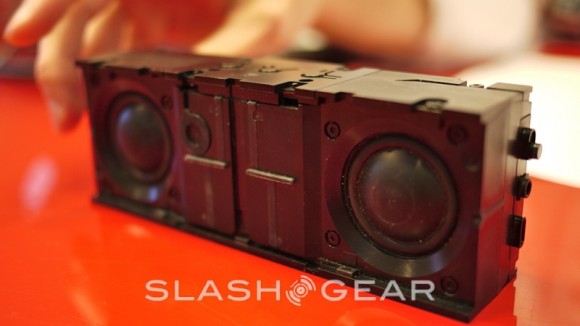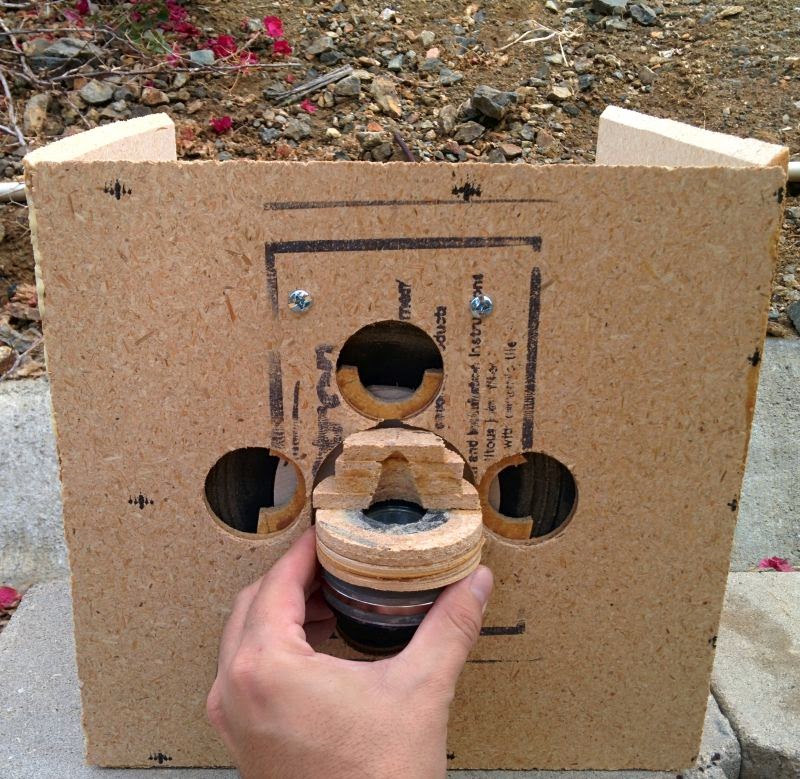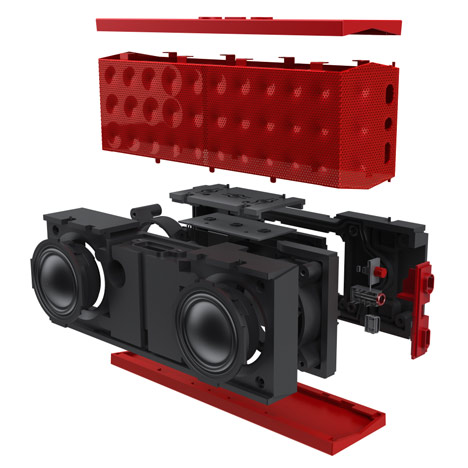
Lately I've been having good luck with Ambiophonics, and good luck with SAW* Lenses.

I decided to combine the two of them into a single unit. It's a single box speaker, that plays music in stereo. It works on the principle of Ambiophonics to create a stereo image, even though the speakers are directly in front of you.
An externally hosted image should be here but it was not working when we last tested it.
Some people do ambiophonics with a physical barrier. The reason that the barrier works is that it keeps the left speaker from interfering with the right speaker. It occurred to me that you could get a lot of these benefits by putting the speakers on the *side* of the enclosure, instead of the front.

For instance, with a speaker like the Jambox, the drivers are seperated by about ten centimeters. But people have had plenty of good things to say about the Jambox, particularly in an Ambiophonic setup.

Put the speakers on the side of a cube, and you increase the seperation five-fold.
* Sausalito Audio Works Lens, AKA "Beolab Lens"



Some pics of the SAW lens coming together
An externally hosted image should be here but it was not working when we last tested it.

The real deal






Figuring out how to mount the SAW lens was tricky... Ended up using velcro. I wanted to get the lens as close to the woofer as possible. That meant that the lens is actually recessed into the cone. Going this route improves the polar response, the frequency response, and the phase response. At a crossover point of 1350hz, getting the tweeter an inch closer to the woofer makes a measurable improvement.


The midbass taps are located at the edges of the cone
Similar to a Unity horn



If my U̶z̶i̶ BMS wasn't heavy I'd probably fire it
I'd make you walk the plank if I was a pirate
If they made me a king I would be a tyrant
If you want to get me go ahead and try it
https://www.youtube.com/watch?v=yPkNE1fdlJ8
Last edited:

^^ The crossover isn't 100% yet, but this crossover has me close to flat.
The woofer is "theoretically" a B&C 8NDL51. I bought them about a decade back, and the person who sold it to me told me it was a prototype. The label on the driver is different though, and I've noticed that the part number is similar (or identical?) to part that's used by QSC.
TLDR: if you want to try this at home, a B&C 8NDL51 is the way to go.
The compression driver is a BMS 4540ND. A JBL 2408H-1 will probably work well too, and it is cheaper.
A clarification on my B&C woofers:
1) they were sold to me as "8NDL51", which is a fairly popular midbass. I was told they were prototypes
2) they are labeled "8NX-TWP"
3) There are no speakers on the B&C site that match this naming, past or present
4) QSC *does* list a "8NX" in their parts catalog. The price is nearly half as much as an 8NDL51 : SP-000109-00
1) they were sold to me as "8NDL51", which is a fairly popular midbass. I was told they were prototypes
2) they are labeled "8NX-TWP"
3) There are no speakers on the B&C site that match this naming, past or present
4) QSC *does* list a "8NX" in their parts catalog. The price is nearly half as much as an 8NDL51 : SP-000109-00
I heard those B&O speakers in their showroom. Other than looking good, there was nothing spectacular about them. Heck, they didn't even get the balance right.
I've heard that a lot.
I've listened to them too, and they reminded me of my Summas. Big wide soundstage.
The highs on the Summa, and the highs on the B&O sound "weird" at first. This is because they're constant directivity speakers, and most people are accustomed to dome tweeters.
After living with the Summa for about a day, I now find dome tweeters to sound very weird. Too bright.


Here's the polar response on the Beolab 5, and the AI ESP15, which is basically the same as my Summas. (new Summas are different. My Summa was purchased in '08)
Note the beamwidth on the Summa is much narrower than the Beolab 5, but the Summa has better controlled response. This is likely because the Beolab uses two lenses and the Summa uses a single waveguide. This is one of the reasons I am using a single lens on my speaker; I think a single lens should have better behaved polars. (And note everything after the Beolab 5 used one lens, not two.)
I've listened to them too, and they reminded me of my Summas. Big wide soundstage.
The highs on the Summa, and the highs on the B&O sound "weird" at first. This is because they're constant directivity speakers, and most people are accustomed to dome tweeters.
After living with the Summa for about a day, I now find dome tweeters to sound very weird. Too bright.


Here's the polar response on the Beolab 5, and the AI ESP15, which is basically the same as my Summas. (new Summas are different. My Summa was purchased in '08)
Note the beamwidth on the Summa is much narrower than the Beolab 5, but the Summa has better controlled response. This is likely because the Beolab uses two lenses and the Summa uses a single waveguide. This is one of the reasons I am using a single lens on my speaker; I think a single lens should have better behaved polars. (And note everything after the Beolab 5 used one lens, not two.)
Last edited:
Er... excuse me, this seems interesting, but I can't figure out how your speaker really looks like, and how it works by the post #1-#4.
Er... excuse me, this seems interesting, but I can't figure out how your speaker really looks like, and how it works by the post #1-#4.

Here is a diagram of the enclosure. This is to scale. It is a cube that measures 26cm x 33xm x 33cm. The enclosure has a wall down the middle, so that each woofer gets it's own airspace. The woofer for the left channel faces to the left, the right channel to the right.

Most 'single box stereo' speakers, like the Jambox, have the woofers on the front. My speaker has the woofers on the side. Putting the woofers on the side increases the stereo seperation because it increases the center-to-center distance between the two drivers.

Putting the woofers on the side of the box creates an issue for the treble; how do you generate high frequencies when you're listening at a hundred and eighty degrees off axis? My solution was to use a Sausalito Audio Works lens, the same lens used in the Beolab line of speakers. The SAW lens has a beamwidth that exceeds one hundred and eighty degrees. So I am listening to the drivers a hundred and eighty degrees off axis, but the frequency response is still the same shape. That's the key to the whole design; it would be challenging to do this speaker any other way. If you simply put a dome tweeter in there and listened 180 degrees off axis the highs would be rolled off.



Some closeups of my lens

A closeup of the Beolab lens
+1 CLS, intriguing, but how is it stereo, what signal is it being fed....
.. you posted while I was wondering 🙂
.. you posted while I was wondering 🙂
Mr Bateman, you post a lot of pretty photos, diagrams and theory but have you ever measured your finished designs or is it all subjective listening experience only?
Just curious.
Just curious.
+1 CLS, intriguing, but how is it stereo, what signal is it being fed....
.. you posted while I was wondering 🙂

It is being fed a stereo signal. Nothing fancy is going on here; I'm just taking two speakers and putting them in a single box. Picture a typical living room on the left, with a typical stereo triangle, speakers seperated by two meters.
On the right, I've shrunk the footprint down, to a size that will fit right in front of the listener. The idea is to have a speaker that you can listen to at your desk in your office. That's why the front of the enclosure is flat; I am going to bolt my LCD monitor right onto the speaker box. The typical computer setup uses puny little speakers that cost $50. I sit in front of a computer for fifty or sixty hours a week, so I wanted something nicer.
The speakers on the left are seperated by two meters. 170hz is two meters long. As soon as two sources are separated by one quarter wavelength or greater, they start to "sound" like two seperate sources. So the two speakers on the left, in the typical stereo triangle, are going to start sounding like two seperate sources at 42.5hz, and the seperate will only increase as we go higher in frequency.
The two speakers on the right will exhibit the same behavior beginning at 170hz, and the effect will only get larger as you go higher in frequency. Personally, I am using an Ambio4you processor to increase the width, but the effect is quite subtle; the two speakers are already seperated by half a meter, so the separation is quite good already.
Mr Bateman, you post a lot of pretty photos, diagrams and theory but have you ever measured your finished designs or is it all subjective listening experience only?
Just curious.
Here's a few thousand:
patrick bateman site:diyaudio.com measurement - Google Search
patrick bateman site:diymobileaudio.com measurement - Google Search
I haven't been counting, but I'm fairly certain that I am one of the most prolific and active posters of car audio measurements in the world. There are a handful of people who have posted more (bikinpunk comes to mind), but I'm up there.
As for "finished designs", I'm way to ADD to finish anything. My car has a stock Lexicon system, I have a set of Gedlee Summas in the garage (my wife banished them for being too big for the living room) and Vandersteens in my living room.
Last edited:
... so your chipboard 'enclosure' is only half built???
Yes, this is a work in progress
One tweeter in the middle, so it's (kind of) a "Stereolith" ?
If so, you can make a comparison between the lens and simple upfiring.
If so, you can make a comparison between the lens and simple upfiring.
Or the opposite, go for maximum beaming
and focus to the corners of the ceiling.
Maybe put something rough or spherical
in the corners to help disperse...
I doubt its possible, but if we compare to
ambiolunacy, not really any less plausible...
Just run you a pair of plane wave tubes
all the way to the corners... Hide the
exact termination length with a K-cut.
Perhaps a three fingered clothes-pin?
Be like crazy PVC or copper rabbit ears
coming out of this central box and lazy
leaning into the corners of the ceiling.
Maybe put a hard glass ball on the end to
prevent gouging the walls and dome out
the dispersion a little bit...
If you are going nuts, why stop halfway?
and focus to the corners of the ceiling.
Maybe put something rough or spherical
in the corners to help disperse...
I doubt its possible, but if we compare to
ambiolunacy, not really any less plausible...
Just run you a pair of plane wave tubes
all the way to the corners... Hide the
exact termination length with a K-cut.
Perhaps a three fingered clothes-pin?
Be like crazy PVC or copper rabbit ears
coming out of this central box and lazy
leaning into the corners of the ceiling.
Maybe put a hard glass ball on the end to
prevent gouging the walls and dome out
the dispersion a little bit...
If you are going nuts, why stop halfway?
Last edited:
those lenses look like a job for a 3D printer...

3D printing would be ideal. But you can get very good results with $20 worth of drill bits and $5 worth of 1/4" MDF. The diagram above shows how to make one of these lenses. The reason why it's so easy to make these by hand is that the elliptical piece is only working from 13500hz-20khz. Literally a fraction of an octave, and an octave that we're not terribly sensitive to. So if you don't get the elliptical part perfect, you likely won't hear a difference.
But, yeah, 3D printing would be sweet, and it would look sharp too. But would it be audibly better? Probably not.
- Status
- Not open for further replies.
- Home
- Loudspeakers
- Multi-Way
- Soundbar Bateman Style
